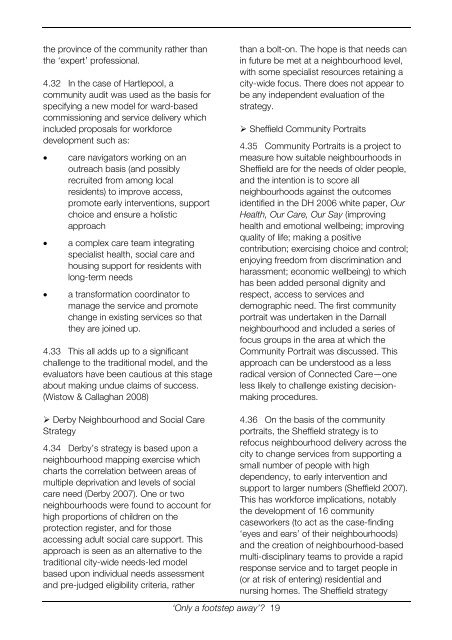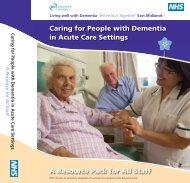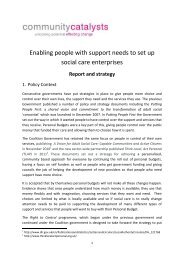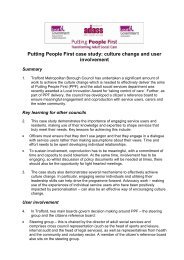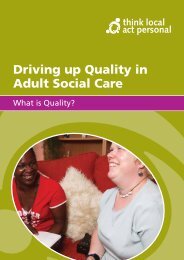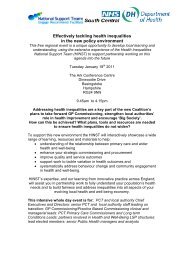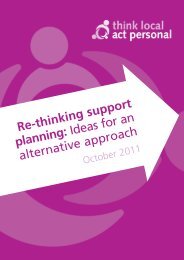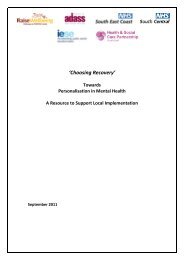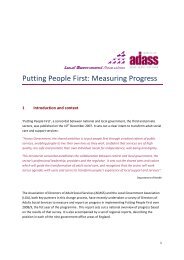'Only a footstep away' - Skills for Care - Think Local Act Personal
'Only a footstep away' - Skills for Care - Think Local Act Personal
'Only a footstep away' - Skills for Care - Think Local Act Personal
- No tags were found...
Create successful ePaper yourself
Turn your PDF publications into a flip-book with our unique Google optimized e-Paper software.
the province of the community rather thanthe ‘expert’ professional.4.32 In the case of Hartlepool, acommunity audit was used as the basis <strong>for</strong>specifying a new model <strong>for</strong> ward-basedcommissioning and service delivery whichincluded proposals <strong>for</strong> work<strong>for</strong>cedevelopment such as:• care navigators working on anoutreach basis (and possiblyrecruited from among localresidents) to improve access,promote early interventions, supportchoice and ensure a holisticapproach• a complex care team integratingspecialist health, social care andhousing support <strong>for</strong> residents withlong-term needs• a trans<strong>for</strong>mation coordinator tomanage the service and promotechange in existing services so thatthey are joined up.4.33 This all adds up to a significantchallenge to the traditional model, and theevaluators have been cautious at this stageabout making undue claims of success.(Wistow & Callaghan 2008)than a bolt-on. The hope is that needs canin future be met at a neighbourhood level,with some specialist resources retaining acity-wide focus. There does not appear tobe any independent evaluation of thestrategy.‣ Sheffield Community Portraits4.35 Community Portraits is a project tomeasure how suitable neighbourhoods inSheffield are <strong>for</strong> the needs of older people,and the intention is to score allneighbourhoods against the outcomesidentified in the DH 2006 white paper, OurHealth, Our <strong>Care</strong>, Our Say (improvinghealth and emotional wellbeing; improvingquality of life; making a positivecontribution; exercising choice and control;enjoying freedom from discrimination andharassment; economic wellbeing) to whichhas been added personal dignity andrespect, access to services anddemographic need. The first communityportrait was undertaken in the Darnallneighbourhood and included a series offocus groups in the area at which theCommunity Portrait was discussed. Thisapproach can be understood as a lessradical version of Connected <strong>Care</strong>—oneless likely to challenge existing decisionmakingprocedures.‣ Derby Neighbourhood and Social <strong>Care</strong>Strategy4.34 Derby’s strategy is based upon aneighbourhood mapping exercise whichcharts the correlation between areas ofmultiple deprivation and levels of socialcare need (Derby 2007). One or twoneighbourhoods were found to account <strong>for</strong>high proportions of children on theprotection register, and <strong>for</strong> thoseaccessing adult social care support. Thisapproach is seen as an alternative to thetraditional city-wide needs-led modelbased upon individual needs assessmentand pre-judged eligibility criteria, rather‘Only a <strong>footstep</strong> away’? 194.36 On the basis of the communityportraits, the Sheffield strategy is torefocus neighbourhood delivery across thecity to change services from supporting asmall number of people with highdependency, to early intervention andsupport to larger numbers (Sheffield 2007).This has work<strong>for</strong>ce implications, notablythe development of 16 communitycaseworkers (to act as the case-finding‘eyes and ears’ of their neighbourhoods)and the creation of neighbourhood-basedmulti-disciplinary teams to provide a rapidresponse service and to target people in(or at risk of entering) residential andnursing homes. The Sheffield strategy


